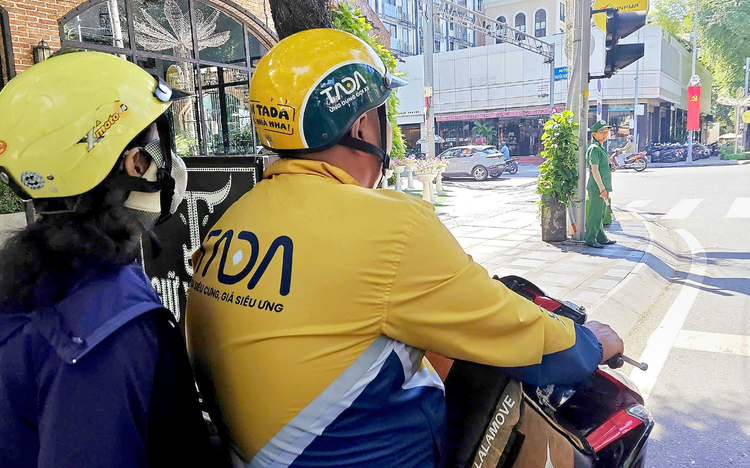
Ride-hailing app Tada from Singapore enhances efforts to gain a foothold in the Vietnamese market. Photo: Cong Trung / Tuoi Tre
In Ho Chi Minh City, Tada’s drivers in bright yellow uniforms and Moovtek’s distinctive purple electric cars are becoming an increasingly common sight.
Though still modest in scale, both ride-hailing brands are carving out niches by offering cheaper fares, zero peak-hour surcharges, and unique ride-sharing options.
“I took a Moovtek car home, and it was about VND15,000 [US$0.6] cheaper than Grab,” said Minh Tam, 27.
“The ride was smooth and clean, though I had to wait a bit longer.
"If they can speed up pick-up times, I would consider using it regularly."
Tada’s standout feature is its zero-commission policy for drivers, an uncommon approach, previously tried in markets like South Korea and Singapore.
This model allows drivers to retain full fare earnings, providing a more stable income despite currently lower demand.
Tada also promises no price hikes during peak hours, a major draw for cost-conscious riders.
“Tada doesn’t get a commission, so I earn more per trip," shared Tada driver Hoang Phuc.
"However, rides are still few and far between.
"Sometimes, I wait quite a while for a booking."
Launched in October, Moovtek is piloting operations in Ho Chi Minh City with a fleet of VF5 electric cars and services spanning motorbikes, standard car rides, and a standout shared ride model.
Fares are reported to be 10-20 percent lower than the market average.
The carpooling feature, aimed at saving riders up to 40 percent on fares, automatically matches passengers with similar routes within 5-15 minutes.
If no match is found, the ride proceeds solo at the same price.
However, one ride-hailing expert noted that while shared rides sound appealing, the model faces operational challenges.
In dense urban areas like Ho Chi Minh City, Vietnamese riders are still not used to sharing rides with strangers.
Also, shared rides must be incredibly precise to avoid detours and long waits.
A representative from Moovtek said that the ride-matching algorithm is built in-house, using real-time traffic and location data to align with its mission of offering a green, affordable, and shared mobility platform.
Major players fight back
Due to the arrival of these newcomers, Grab and Xanh SM have accelerated their own innovation efforts in response.
In mid-October, Grab launched GrabCar Electric in Hanoi, stepping into the EV arena currently dominated by Xanh SM.
While Xanh SM owns and operates a dedicated EV fleet, Grab is taking an open-ecosystem approach, encouraging its drivers to switch to EVs independently.
Grab is partnering with companies like Selex Motors and financial institutions to offer EV purchase incentives, said Nguyen Hanh Linh from Grab Vietnam.
Grab has also introduced electric and hybrid car options with 50 percent off for first-time users and 15-percent discounts during peak hours.
Additionally, new ride cancelation policies and automated trip data analysis aim to improve transparency between riders and drivers.
Xanh SM, meanwhile, has rolled out a new ‘Scam Alert’ feature for drivers, classifying ride risk on a four-level scale to prevent misconduct and protect compliant drivers.
Be Group, Vietnam’s homegrown ride-hailing service, is enhancing its tech backbone by integrating AI across core functions.
The company reports a 30-percent reduction in wait times, supported by weather and event analyses, and real-time traffic data.
Delivery giant joins the race
It is not just traditional ride-hailing platforms making the move, but logistics firm Lalamove is also entering the ride-hailing market.
Starting from the fourth quarter of 2025, users in Ho Chi Minh City can book motorbikes and cars with four- and seven-seaters directly through the app.
“This is the first step in our personal transport strategy, which we plan to expand across major Vietnamese cities,” said Nguyen Hai Dang, CEO of Lalamove Vietnam.
Founded in Hong Kong in 2013, Lalamove operates in over 400 cities across 11 countries and entered Vietnam in 2017.
With a strong logistics network and experience piloting ride-hailing in countries like Thailand and Indonesia, the company sees Vietnam as ripe for diversification.
Market full of potential and pitfalls
Despite predictions that Vietnam’s ride-hailing market could reach $9 billion by 2030, according to Google, Temasek, and Bain & Company, industry insiders caution that success will require more than just low prices.
“Vietnamese consumers are extremely price-sensitive but also demand stable service, seamless tech, and professional drivers,” said the industry insider.
“That’s a tough balance and requires sustained investment.”
International and local players like Uber, Gojek, Baemin, FastGo, and Mai Linh Bike have exited the market in recent years due to fierce competition and high operational demands.
While newcomers like Moovtek and Tada offer appealing entry points through pricing, experts warn that longevity will depend on broader capabilities–scalable technology, robust driver communities, and sustainable financial backing.


Max: 1500 characters
There are no comments yet. Be the first to comment.